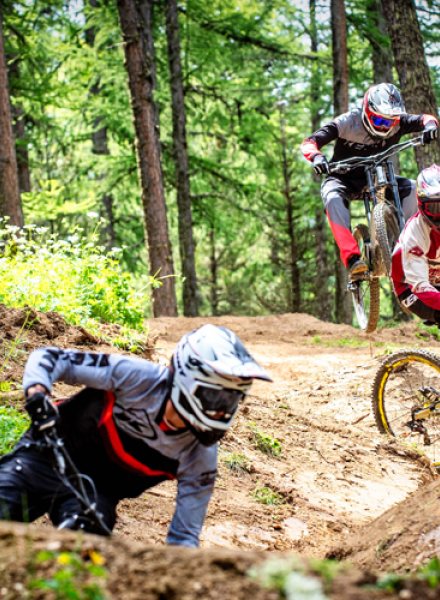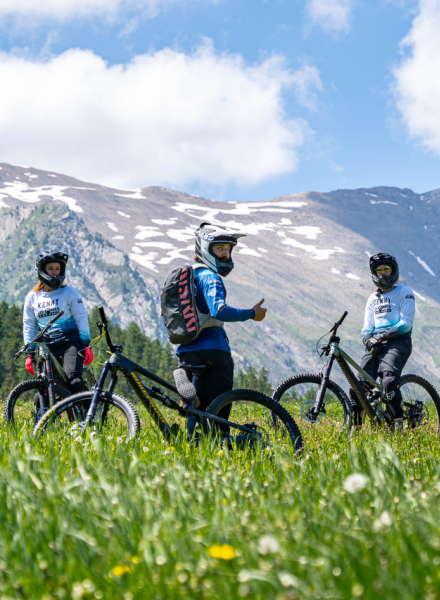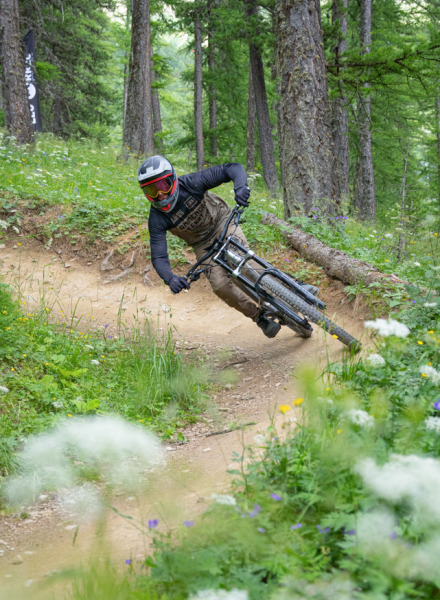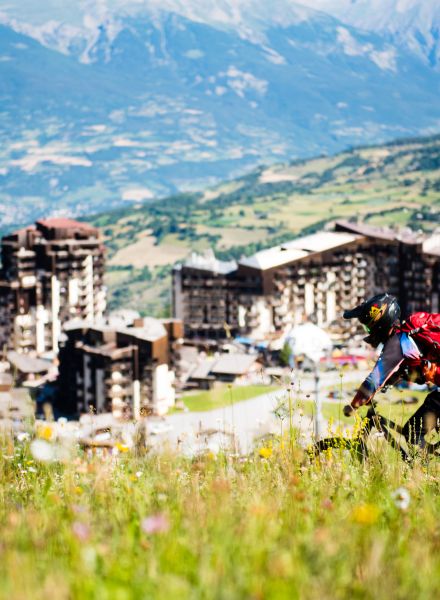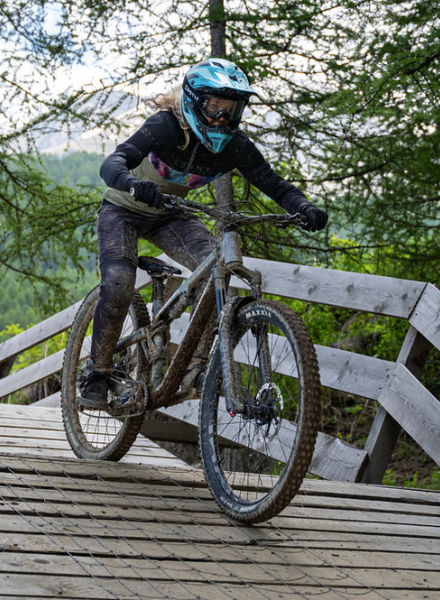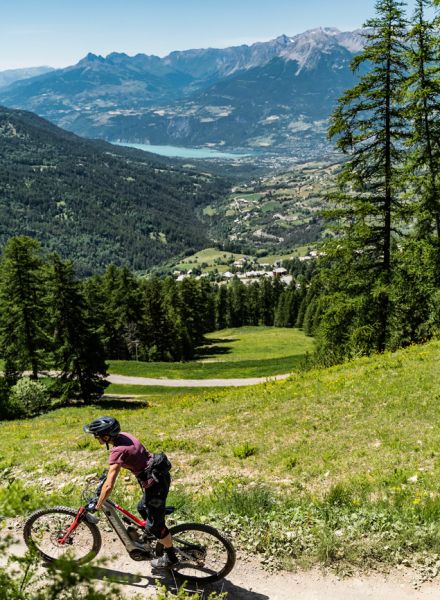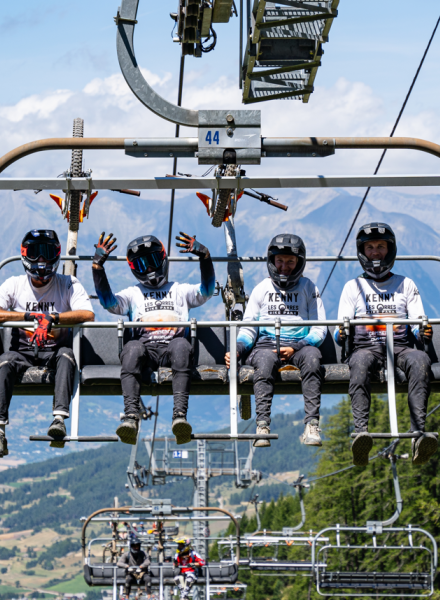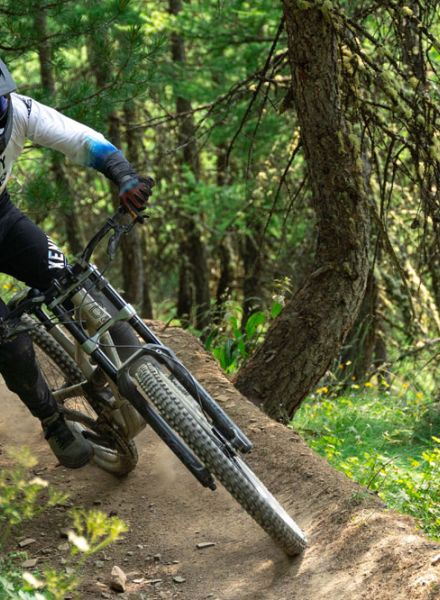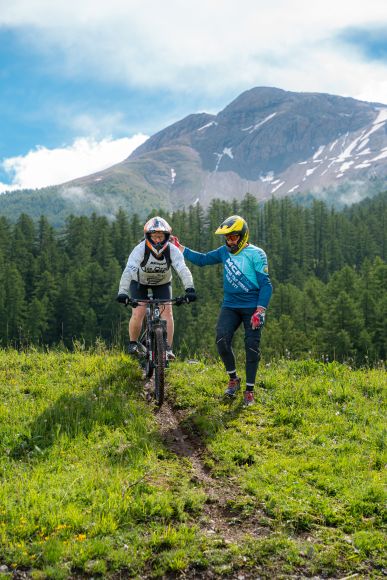

5 tips for your first day at a bike park
5 tips for your first day at a bike park
Do you want to join the family of downhill mountain bikers, but don 't know where to start? Mountain biking on resort trails is accessible to all, but it can't be improvised.
Certain criteria are essential: choosing the right bike, protecting yourself with the right equipment, making sure you're in good physical condition... Ticking the right boxes is the guarantee of maximum Bike Park pleasure.
Sébastien Aubert, mountain bike enthusiast and head of the Horizon Tout Terrain mountain bike school in Les Orres, gives you 5 of his top tips for avoiding the pitfalls.
ADVICE #1
Know where you ride: what exactly is a bikepark?
Experienced riders know exactly what we're talking about. But for others, it's not so intuitive. Depending on the country and the person questioned, the answers are always different. Even among mountain bikers, we don't always agree. So, what is a bike park? A landscaped area with natural and artificial obstacles? A concrete area with modules for practicing jumps and banked turns? A succession of downhill runs in a resort? A place where you can practice mountain biking, like in the UK? A bike park? The equivalent of a skate park for mountain bikes? Not so obvious!
Here's a definition that's as close to reality as possible: a bike park is an area entirely dedicated to mountain biking, with specific facilities and services.
At Les Orres bike park, a network of 13 downhilltrails has been laid out to offer more or less technical descents: jumps, banked turns, roots, bumps and hollows, wooden modules... All you have to do is buy your ski pass, choose your run, get to the start from the comfort of one of the resort's chairlifts and off you go! A washing area, qualified instructors and equipment rental are all available on site.
ADVICE #2
Acquire a minimum of technique
You've never set foot in a bike park and wonder if it's for you? You've done some mountain biking or even a few downhill runs, but you're afraid to take the plunge? You don't have to know how to do a double backflip to enjoy yourself. Expert, beginner or somewhere in between, it doesn't matter. All you have to do is choose a descent suited to your level, your desires and your current form . Easy, the level of the slopes follows the same codes as for skiing, from the easiest (the green ones) to the most arduous (the black ones, even the ultra-black ones).
You'll still need a few technical skills to enjoy yourself and avoid falls. Speed requires concentration and control of your bike. Mastering riding techniques such as braking,balance and cornering is essential for safe riding.
The best way to learn and progress is to spend a few hours with a mountain bike instructor. This will save you a lot of time. You'll also avoid developing bad habits that will be hard to correct later on. Taking ski lessons makes sense. So why not do the same with your bike?
You can also train on terrain similar to that of the bike park. As soon as you get the chance, practice reading the terrain and making quick decisions to improve your reactivity. And above all, ride whenever you can. In any case, it's the riders who take care of themselves and ride intelligently who progress and go the furthest.
TIP #3
The best bike for bike park fun

Several types of mountain bikes are available for the trails. Every rider has his or her own preference. If you don't have your own equipment, you can rent it at Les Orres 1650 and 1800. It's the ideal way to try out the equipment and the bike park trails. The rental companies will advise you on the bike best suited to your needs.
Here are the best choices for your session:
- All-mountain mountain biking: are you a beginner or an intermediate? You can explore the resort's trails on an All-Mountain. The only requirement is a minimum travel of 150 mm. It's the perfect way to enjoy the beautiful blue and red descents.
- Downhill mountain biking (DH) : downhillers looking for speed, bumpy descents and more broken, technical trails will opt for a downhill mountain bike (DH). This rugged bike is specially designed for rough terrain and fast descents.
- Enduro bikes: the perfect compromise between the two. Versatile, these bikes are more than enough for Bike Park fun as well as for cross-country riding. They offer a good balance between downhill ability and pedaling efficiency.
- And there's one more bike that's not for beginners, but that's part of the landscape: the freeride mountain bike. Reserved for riders who enjoy extreme descents, jumps and acrobatic tricks. They are generally more versatile than downhill mountain bikes, with medium travel (150-180 mm) and more solid construction to withstand hard landings.
TIP #4
The optimum protection kit
Safety is the top priority when you're riding in a bike park. Here's a list of essential protective equipment:
- Full-face helmet: mandatory in the bike park. Make sure your helmet is approved for mountain biking and fits your head properly.
- Gloves: as well as offering protection in the event of a fall, they also improve your grip on the handlebars. Choose gloves specifically designed for mountain biking, with good grip and reinforced palm protection.
- Goggles: these will protect your eyes from debris, branches and dust during the descent. Shock-resistant lenses and good ventilation are ideal. There's nothing worse than fogging up your lenses when you're concentrating on your descent and dealing with obstacles!
- Shoes : it's best to wear mountain-bike-specific shoes. They have a rigid sole that guarantees good power transmission when pedaling, and better grip if you have to walk on uneven terrain.
Useful extras: a small rucksack with a hydration pocket, a basic tool kit for emergency repairs (pump, Allen keys, tire levers and spare inner tube), snacks.

ADVICE #5
Take it easy!
- Advance gradually: make sure your progress is gradual. By starting with the easier runs, you'll quickly improve and move on to the more technical descents. Respect your limits and don't rush.
At Les Orres, the two green trails in the "Easy ride" zone are designed for a first approach to DH mountain biking. Take it easy, in complete safety. You'll soon move on to the four blue trails, where you can try out more or less gentle descents, a few modules and banked turns to build up your confidence and taste your first thrills. Ready for the next level? The reds are yours! Whatever your choice, you'll progress at your own pace, taking on new challenges as you go.
- Take time to get to know the terrain. An initial gentle descent allows you to spot the bends and various obstacles. You'll then be able to move on to the second run more quickly. In all cases, adapt your speed.
-
A team of Bike Patrols roam the bike park throughout the day to make sure everything runs smoothly. They're dressed in distinctive outfits, so you'll recognize them easily. Don't hesitate to ask them for information, advice or help if you need it. That's what they're there for.
-
Recovery counts! Give yourself plenty of rest after your workout or bike park session.
Gawa's advice
"The scenery is incredible, and it's just too good. But you don't want to get too hot, because it's not skiing. The level of the bike trails can be a little tighter. So you have to adapt to them and not go straight for runs that aren't up to your level. In a bike park, you can pick up speed straight away, because you're in the mountains, and let yourself get carried away. So don't jump the gun, start slowly. And then go out and discover and enjoy yourself!"
Ready to get started?
Take action!
Take a mountain biking course Discover the bike park Book your package


